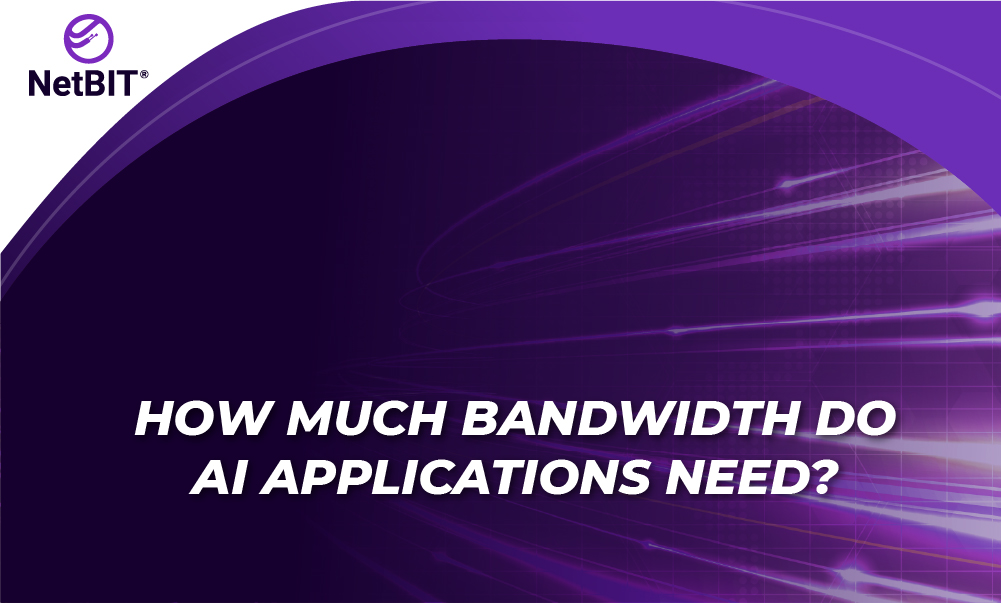Artificial Intelligence (AI) is transforming the way businesses operate, from analyzing massive volumes of data to automating critical processes. Yet, behind every intelligent model and every real-time application, there is a technical factor that often goes unnoticed but is absolutely essential: bandwidth.
Asking how much bandwidth an AI system needs is far from trivial. The answer depends on multiple variables such as the type of application, the volume of data it processes, the deployment environment (on-premises, cloud, or hybrid), and the way users interact with the system. Correctly sizing bandwidth can be the difference between an efficient AI solution and one that falls short.
The Role of Bandwidth in AI
Bandwidth refers to the data transmission capacity of a network. In AI applications, it is not only about speed, but about ensuring that the flow of information —often in real time— is constant, secure, and uninterrupted.
An AI system may be receiving input from IoT sensors, processing customer interactions online, pulling information from cloud databases, or delivering results to end users. In all these cases, sufficient bandwidth is essential to:
-
Process large volumes of data without delays.
-
Enable cloud collaboration without service interruptions.
-
Guarantee real-time responses in mission-critical applications (e.g., cybersecurity, medical diagnostics, financial trading).
-
Maintain a seamless user experience in conversational or interactive systems.
Key Factors That Determine Bandwidth Consumption
Not all AI systems require the same level of network performance. Some can work with standard connections, while others demand enterprise-grade bandwidth. The most important factors include:
1. Type of AI Application
-
Cybersecurity AI: must analyze millions of events per second, requiring continuous, high-performance traffic.
-
Natural Language Processing (chatbots, assistants): requires low latency for fluid responses, but not always large data volumes.
-
Computer Vision and Video Analytics: highly bandwidth-intensive, especially when streaming video is processed in real time.
-
Predictive Analytics in the Cloud: requires sending large sets of historical and real-time data for processing.
2. Volume and Speed of Data
The more data the system ingests, the more bandwidth it requires. For instance, AI for medical imaging must transfer large, heavy files, while an e-commerce recommendation engine mostly handles lighter transaction data.
3. Deployment Environment
-
On-premises: reduces reliance on external bandwidth but demands robust internal networks.
-
Cloud: heavily dependent on connectivity to providers such as AWS, Azure, or Google Cloud.
-
Hybrid: requires balance as data flows between local servers and the cloud.
4. Number of Concurrent Users
If an AI system is serving hundreds or thousands of simultaneous users, bandwidth must be dimensioned not only for the model’s data but also for user interactions.
5. Latency Requirements
Applications like autonomous vehicles, real-time diagnostics, or cybersecurity cannot tolerate delays. Here, low latency and network stability are more important than raw bandwidth volume.
PONENTES
NetBIT Secure
Symmetric / Dedicated Internet Service with Logical Security, composed of high quality and high end equipment.
NetBIT Secure adapts to the speed of your business.
Written SLA guarantee. Installation and implementation within days. Configurable policies according to your needs.
Real-World Bandwidth Scenarios in AI
-
Enterprise chatbot with 1,000 users: may need between 50 Mbps and 200 Mbps depending on query complexity.
-
Real-time video analytics: a single HD stream consumes 3–6 Mbps; 100 cameras may require 300–600 Mbps.
-
Cybersecurity AI for large corporations: often exceeds 1 Gbps to process massive event streams.
-
Financial trading AI: moderate data volume, but ultra-low latency with dedicated, stable bandwidth is a must.
Risks of Insufficient Bandwidth
Underestimating bandwidth needs can lead to serious consequences:
-
High latency: delayed chatbot responses or lagging analytics.
-
Service interruptions: when networks become saturated with traffic.
-
Incorrect decisions: if data arrives incomplete or too late for accurate processing.
-
Loss of productivity and trust: frustrated users, unattended clients, or even critical business failures.
Strategies to Optimize Bandwidth for AI
Although bandwidth demands can be high, there are practical ways to optimize it:
-
Edge Computing: process data where it is generated and send only relevant insights to the cloud.
-
Data Compression: reduce file sizes without compromising model accuracy.
-
Traffic Prioritization (QoS): ensure AI workloads take precedence over less critical services.
-
Dedicated or Segmented Networks: isolate AI traffic from other business processes.
-
Cloud Scalability: leverage flexible provider options to scale network resources as demand fluctuates.
Looking Ahead
As AI evolves into more complex models —from large language models (LLMs) to 8K computer vision systems— bandwidth consumption will only increase. Emerging technologies such as 5G, advanced optical networks, and edge computing will be essential to sustain this growth.
Businesses planning to integrate AI must realize that their network is not just a support layer, but a strategic asset. Properly dimensioning bandwidth ensures not only smooth operations but also the ability to scale and remain competitive in an environment where data speed equals business advantage.








